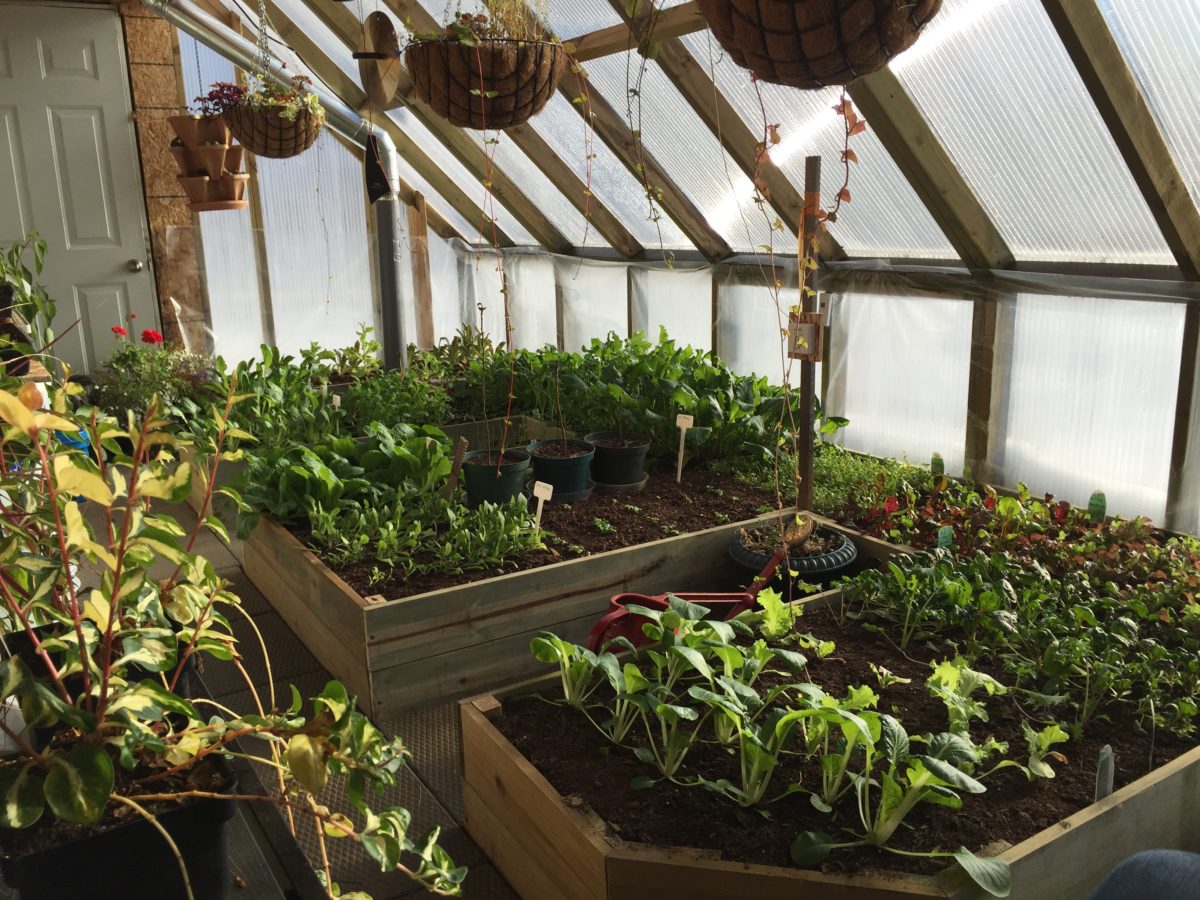
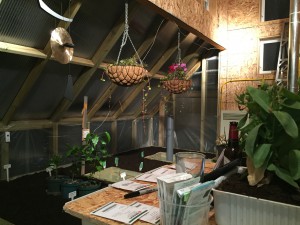
After a long couple years of planning and building, magic happened at the end of October 2014. The first seeds were planted in the raised beds of my experimental all-season urban greenhouse. It’s a bit of an understatement to say I was excited. It was like Christmas morning as a kid amplified about ten times.
For those new to the blog, here’s a bit of history on what I am working to accomplish:
In a nutshell, all-season food production in a northern urban yard, and sharing that information to inspire and encourage great folks like yourself to grow food in this harsh climate.
How I am going about this is by converting my urban yard into a mix of relaxing/entertaining space, some grass, a large number of raised beds, a micro-orchard and an experimental all-season greenhouse that will hopefully work in both winter and summer to keep a continuous supply of fresh greens and produce available. And I hope to accomplish this with a minimal amount of resources (ie, minimal heat and no supplemental lighting, as well as rain barrels through summer and year-round composting).
What I am not trying to accomplish is commercial food production. 1-2 households would be a great outcome in my mind, and if there are extras to share, BONUS!
So how have my first three months gone? I’d say fairly well, with a lot of learning! Plants and nature are excellent teachers. I’ve had a wonderful mix of wins and lessons (I will not call them failures, because they teach me the most!) and I’m excited to share them with you.
Thinking back, before building even began I was researching and creating plans in my head. During that I recognized I would have a number of hurdles to overcome. The largest included:
- Low light in the Persephone Period of the year
- Maintaining the greenhouse temperature without high cost
- Moving the greenhouse through the seasons without overheating or over-cooling (especially the highly variable spring and fall)
- Limited space
The Persephone Period:
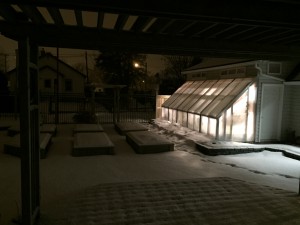
As excited as I was to be planting in the last few days of October, and at the start of November, I also realized that this meant I was starting the seeds at the exact same time that growth is slowing and going into stasis; The Persephone Period
The length of the Persephone period is different across the globe. The term, first used by Eliot Coleman, refers to the period of the year with fewer than 10 hours of daylight. During this period, little to no plant growth occurs since there is just not enough light for them to generate the needed energy. In the middle is always Solstice, the shortest period of daylight in the year.
Here in Thunder Bay, Solstice was on December 21, 2014, with only 8 hours and 19 minutes of daylight. Of that, only a fraction reaches inside the greenhouse when the sun is highest in the sky, while most is lost along the horizon for the remaining time. In relation to this, the first day of the Persephone Period was Nov 1, 2014, and the last day will be Feb 11, 2015 which is almost a full third of the year. (dates taken from http://www.timebie.com/sun/thunderbayon.php). EXACTLY when I was finally able to plant. I know for a fact I will definitely be starting the first few plants before this date next fall, giving them time to gain some size before they slow to a crawl 🙂
That said, I’m not at all unhappy with the performance of the plants. It was a good lesson learned on when I should plant, and gave me a very clear picture of which of my crops would perform the best with the least light. I’m not sure I would have had this if I had been able to plant sooner. Hurdle of low light overcome? I’d say I have a good start, and some great ideas moving forward.
The Plants:
In the next season I fully intend to stagger my planting, and grow some of the greens in succession to ensure a constant supply through winter (including starting the plants sooner in the season). However since this was the first year, I was more interested to directly compare the plants’ growth to each other, see what grew well, what took longer, what the lights was like in the different spaces, and what I might not plant again. And so I seeded all the varieties within about 3 days of each other starting Oct 30. Most were directly into the raised beds, cabbages and kale were started on my indoor grow table under some grow lights then transplanted.
All together, I planted about 30 types of greens. These included Mei Qing Choi, Joi Choi, White and Red Hakuri Turnips, 5-6 types of lettuce, Red Kitten Spinach, Tokyo Bekana, Bunching onions, Chinese cabbage, Red Russian Kale, Broccoli raab (rapini), Broccoli, Early Jersey and Red Cabbage, White Icicle and Easter Egg radishes, Arugula and Dragon Tongue Arugula (a wild variety), Claytonia, Vit Mache, Bright Lights Swiss chard, and 4 types of micro greens.
Along with these, I also overwintered strawberry plants hoping for an earlier harvest in summer, sweet peppers that were not quite ripened in summer, a herb collection, and a group of decorative flowers and grasses from the summer landscape.
Overall, I have found that crops typically intended as “cold crops” like spinach and kale do live and grow…..but in the lowest points of daylights they are stagnant. So I think these ones will be planted early, but I won’t expect to eat them until later winter once the daylight increases and they “wake back up”.
What surprised me is how well the Tokyo Bekana and other asian greens did with the lack of light. The bekana happily continued to grow and increase in size, ignoring the lack of light, as did both varieties of choi for the most part. So I will expect that these will be my first winter greens each year, and that I’ll be adding in a second or third planting of them through the season.
The other strongest winner was the standard Arugula. It took off in leaps and bounds, and did not care in the least about the cooler temperatures and low light. This was also the very first green I harvested this winter (it made a great addition to Christmas dinner!), and it has continued to grow more and more from the same original plants. Oddly, the wild-type dragon tongue arugula was an incredibly poor performer, and I do not expect I’ll grow it again next season.
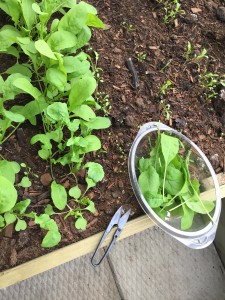
Two plants that I expected great returns from were the Claytonia and Vit Mache. Neither of which produced. However, these are very cold-loving plants, so I am considering moving them to alternate spaces next year to see if I just had them in the wrong spot.
Radishes, turnips, rapini, lettuce and the majority of the other greens have been enjoyable snacking as I thin them, and by the end of the Persephone period are starting to be ready for meals. I will definitely plant fewer of these initially, and stagger in a second to third crop. Except perhaps radishes, which I may increase in number. I was incredibly happy with the white icicle radishes. Sweet and mild, and unlike in summer when they have all bolted in the gardens, the roots developed perfectly. The easter egg radishes were equally enjoyable for snacking, juicy and fresh. WIN for the cool greenhouse soil!!
The microgreens I had a hard lesson on. It was suggested I germinate these on a heatmat before moving them to develop.
I did not listen.
I did not get microgreens in any of the flats.
Even those that started to germinate faded away quickly. So these I’ll have to try over again. Add the heat, and get taught what else they may need. Oops – live and learn, right?
Surprises:
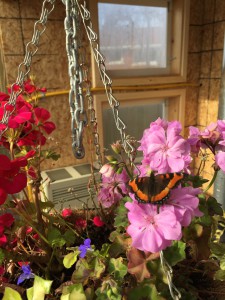
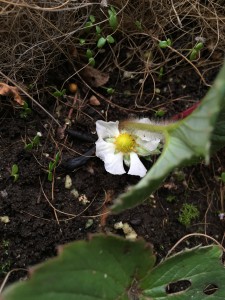
The first 3 months have also had their share of surprises, both wonderful and not-so-great. A butterfly in the first days of November was such a great sight to enjoy, an overwintering Jalapeno decided to try growing new fruit, and one of the strawberries blossomed a few days after Solstice. I’m still shaking my head on that one. And last but not least, even with -40C windchill, the greenhouse was still able to reach a peak around 25C inside on a clear sunny day – all from passive solar.
Not so great included:
– Heat Sink Issues
Although partially functioning, the heat-sink is going to need a simple adjustment in spring. If you recall in the post where I discuss the building of the heat sink, I placed some fabric over the heat pipes within the rocks. I’ve since observed that there is just not enough flow of the heated daily air. This cloth is giving too much back-pressure, and only a trickle of the air can flow in, taking too long to store as much heat as it is capable of. So it is providing some evening heat, and some airflow during the day, but can definitely do better. So awesome, I know the issue and can fix it – not so great, I need to dismantle the beds temporarily in spring and dig down before rebuilding.
– Humidity
Although I was expecting there to be some humidity concerns, I did not expect them to start immediately. Even with very sparse watering, the cooler temperature built up humidity instantly. This was compounded with the heat sink not giving as much airflow as it’s capable of. I did counter this by adding a circulation fan, but I’ll need to consider how to deal with this better the next season.
– APHIDS!
I knew that aphids could be a concern, but after not seeing any for the first long while I assumed I had dodged the bullet this year. Nope. They showed up around the same time as Solstice. At first I kept them under control with a simple 50-50 water-rubbing alcohol mix that I added detergent into. But I finally decided that was not as effective as I wanted, and called in the troops. I’m currently in the middle of a biological treatment using two insects predatory to aphids, Lacewing larvae and parasitoid wasps. I’ll be sure to write up an article on the battle and how it turns out!
Summary:
In summary I’d have to say these first three months have been FANTASTIC! So great in fact I’m wondering when the next shoe will drop…
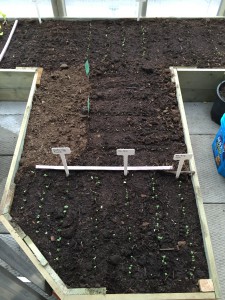
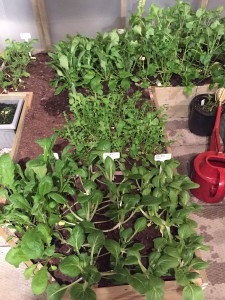
I’m learning a ton, and the plants are being excellent teachers. Showing me what they like, what is not great, when I should plant them and so much more.
As I thought, the biggest issue for the northern winter greenhouse is NOT temperature. It’s the lack of daylight. Before this I knew we had less daylight than other zones, but I did not really understand that we spend almost 1/3 of the year with fewer than 10 hours of daylight, or the implications. But I’ve STILL had fresh, flavor-bursting greens (although not the ones I had originally thought would grow the best) and I’m pumped for the rest of this trial year.
Looking forward to the next few months, as the great north moves into Equinox ! This is gonna be fun… 🙂
Do you have any questions? Please ask in comments, I’m sure I’ve missed some juicy details that I’ll be more than happy to share!


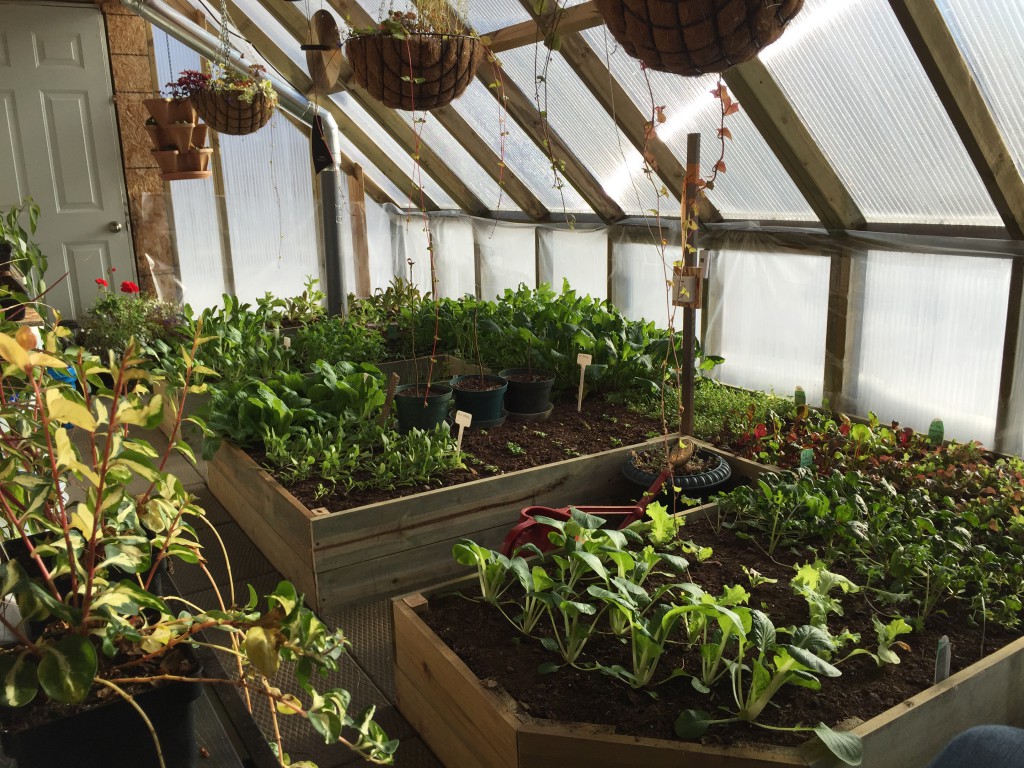

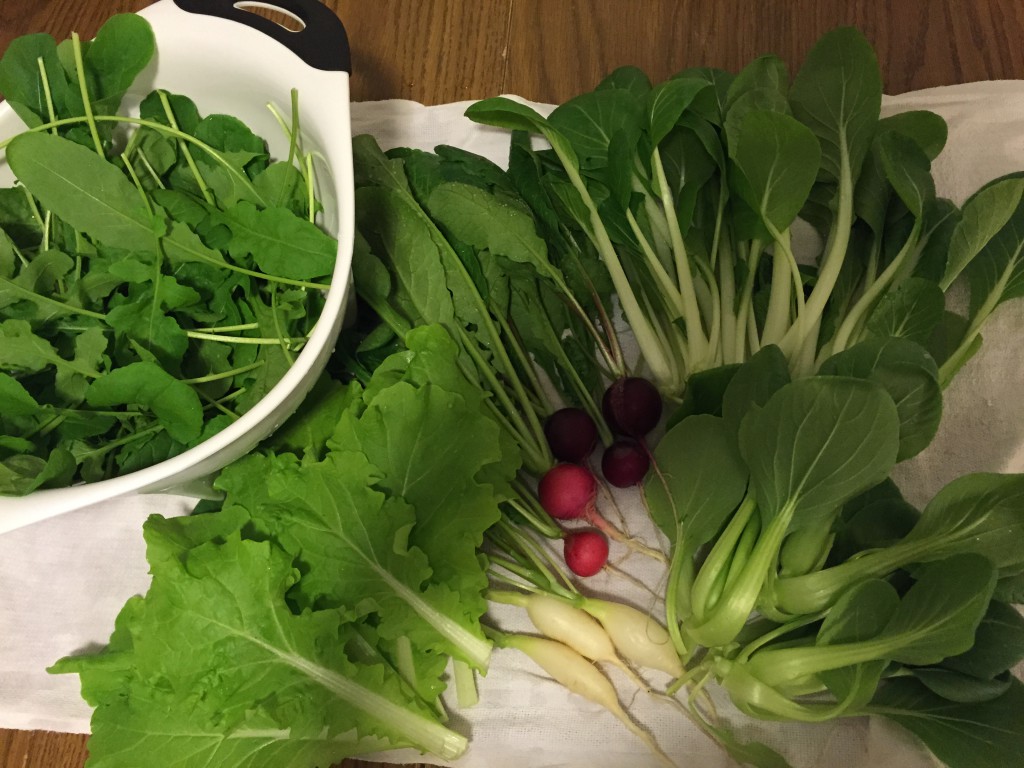
Hi Tallon: I am on the board of the Thunder Bay Horticultural Society and we are hosting an open house and membership drive on March 8th. One of the topics of display for that day will be container gardening, and I specifically want to have vegetable containers there. I have planted some chard and lettuce already and the plants are up, but I am thinking they will not be of much size to repot by the 8th. I am wondering if at all possible I could get some plants from you for this event? And would you be willing to donate them? I am looking for 8 to a dozen plants, enough to fill a 12 to 14 inch pot. I also have some herbs started and would be willing to swap with you, as I have basil, oregano, parsley and sweet marjoram up already, but don’t see any signs yet of the sage and other herbs. I also have a pot of chives growing inside, that I transplanted from my flower bed last summer and fetched indoors a couple of weeks ago. I am going to bring in a couple more pots to start growing too, so I can always pass one of those on to you as well. Let me know what you think.
Thanks,
Phyllis
PS: I have one of those indoor greenhouses and usually start my own bedding outs in it at the end of March or beginning of April, as well as doing winter sowing. I will be starting that next week as well.
Pam:I apologize for not seeing your first name. I saw the article about your greenhouse in the February edition of Walleye, and I am impressed and jealous….(hahaha) Cudos to you on this challenge and succeeding with it so well.
Hi Phyllis. Good to hear from you. I received your reply, and I’ll set-up a time for you to stop in and see if any of the plants will be useful to you. It sounds like you’ve got a lot to get done for the 8th!
Thanks Pam. You can call me if it’s easier. We will be in town on Thursday if that works for you.
Hi Pam,
I recently found your blog from your facebook page and have been catching up reading your archives. Your greenhouse is beautiful. Good job. I wanted to offer a suggestion. I also struggled this year with light. My daughter heard or read somewhere that this was a record breaking or near record breaking year for the amount of cloudy days and I believe that could be true. So before eliminating something from your plant list you might want to try it a second year and see if it does better. Just in case next year is similar my plan is to have stuff near full size by November 7, which is the date Persephone starts for my zip code.
Lorri
Hi Lorri. Thank you for taking the time to drop a note! I’ve been commenting to my hubby all season so far that it just seems so much darker than usual, and that there have been very few sunny days (both to warm the heatsink, and to help the plants along). Keep meaning to look for stats on how this year has compared to others, and how many sunny days we’ve had but just haven’t gotten to it yet. I really need to 🙂
Really glad to hear it’s not just me, and maybe we really DID have a darker Persephone than normal. It sounds like you have a greenhouse or growing space for winter? Is it a new one, or has it been going a few years?
I have a passive solar greenhouse. We spent a couple of years building it on weekends. This is our third winter of growing. It is still a learning process. We built ours on a existing cement slab as there was already water and electricity there so we do not have the underground thermal mass but instead have water in containers. I grow in containers instead of raised beds; both in plastic tubs on tables and in rain gutters and pots suspended from the rafters.
Your shares really got me thinking different about my greenhouse. I may have to add some additional lights to the space. Aphids are EVIL … thank you for sharing tips on those little buggers!
I love this journey as you discover what will work and what needs help and what just won’t work in your lovely space. It is all a learning experience. My challenge this year is to see how much I can grow in my 16’x16′ back patio area but I live in the south so my weather is quite different. I am hoping to create a small removable green house (looking at all my options. I kind of like the one that folds back link an accordion to open and have out of the way) to place over part of it through the winter months to see if I can grow all year long as well.
Regarding the aphids. I had aphid trouble one time, and only one time, in my garden. I planted garlic cloves next to the roots of the plants that had trouble and they quickly decided they didn’t like my garden.
I look forward to seeing the rest of the year and how your growing journey progresses!
I’ve had so much fun Tweeting with you and now I like you even more since I’ve read your blog!! This is an amazing adventure and one I would love to engage in on my small property at some point. For now, I’ll be reading your posts with great interest!
If you get a chance, head on over to http://www.morethanoregano.com and say hello. I’d love to have you visit.
See you on Twitter and at #gardenchat
~Your fellow northern gardener, Beth
You’ll be able to find space hetaers at end-of-season sales now, many for 50% off. I keep a small hetaer in my greenhouse with the thermostat set at 45F. It uses very little energy because even at 25F outside temps, the sun does an amazing job warming the greenhouse up to over 50F during the day. The space hetaer only goes on late at night or early morning before the sun starts to warm things up again. Because heat rises in the greenhouse, the air space at the bottom is not much of an issue as long as your plants are placed at a higher level. You should also place the space hetaer above the air space as well so the cold pocket on the floor is not triggering the thermostat.
[…] Urban “Farming” 365 – The first 3 months (Persephone Period) | Growing North. […]
Good reading and info. Just built a new hoophouse on an i
sland south of Detroit. I look forward to learning from your “”trials “‘